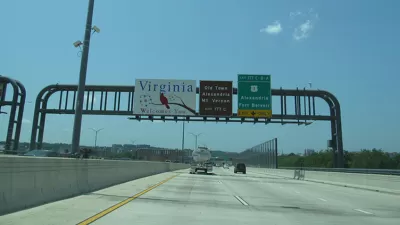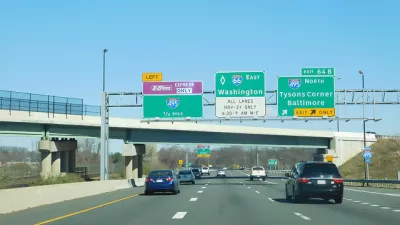The $500 million, eight-mile extension, mostly paid by private funds and express lane tolls, broke ground August 9. Transurban, the private company in the public-private partnership, will pay $15 million annually for public transit improvements.
One new express lane, from Alexandria to Arlington at the border with the District of Columbia [see map (jpg)], will be added, and two existing carpool lanes will be converted to express lanes. Together, the lanes will allow all vehicles to use three reversible lanes for a toll that will rise and fall based on the level of congestion, i.e., dynamic tolling, while reducing carpool cheating, which has been shown to be one of the most serious problems plaguing traditional high occupancy vehicle (HOV) lanes. Adjacent unmanaged lanes will remain toll-free.
"The 395 Express Lanes will operate just like the 95 Express Lanes in Northern Virginia," according to Virginia Department of Transportation's (VDOT) project description.
Carpoolers and sluggers with three or more people in the vehicle will continue to travel for free with an E-ZPass® Flex set to HOV mode. Those willing to pay a toll will be able to access the Lanes 24/7 with an E-ZPass®.
Public-Private Partnership
“Today’s groundbreaking is the first project of the Commonwealth’s larger Atlantic Gateway Initiative which aims to unlock the I-95 Corridor," stated Gov. Terry McAuliffe at the August 9 ceremony. "The Atlantic Gateway Initiative and the I-395 project demonstrate how we can work with our public and private partners to improve the quality of life for Virginians and our visitors – and keep our new Virginia economy growing.”
Plans to extend the Express Lanes began in November 2015 with a Framework Agreement under the 95 Express Lanes Comprehensive Agreement between VDOT and Transurban. In February 2017, after meeting specific project-delivery and financial criteria, the Commonwealth approved Transurban’s proposal to finance, design, build, operate and maintain the 395 Express Lanes extension.
As of press time, this correspondent was unable to locate the amount and source of public funding for the 395 Express Lane project. However, according to Transurban, "[f]unding for the project will come primarily from toll revenue and private investment." Look below under 'comments' for forthcoming funding information from public sources.
Profitable?
A February 2014 post, noting that the 495 Express Lanes, also built and operated by Transurban, lost $51 million in 2013 due to lower than projected traffic volumes, questioned the Australian company's $1.4 billion investment in the $1.9 billion project. However, just two months later, a post indicates that the lanes have been "fetching a pretty penny this year for commuters looking to escape the notoriously congested Capital Beltway," with tolls topping $11.
The toll schedule shows they "range from $0.20 per mile during less busy times, and up to approximately $1.00 per mile in some sections during rush hour."
With Americans' penchant for driving showing no signs of waning, there's no reason to think that private investors will not be interested in building and operating express lanes, particularly on congested corridors. All the more reason for state transportation departments with constrained budgets to partner with the private sector to build these lanes that increase capacity while managing congestion better than HOV or general purpose lane additions.
In Australia, revenues are surging for the toll company, reports the Sydney Morning Herald via MSN. "Tolls in the United States, which make up about 10 per cent of Transurban's earnings, reaped an extra 23.7 per cent."
Transurban to subsidize public transit
"The project includes a long-term investment in transit for the corridor, through a yearly payment of $15 million (to be escalated annually) that will be paid by Transurban to the Commonwealth, " according to VDOT. "This annual transit payment will support transit and multimodal initiatives benefitting the corridor."
According to the March 1 agreement [pdf] between VDOT and Transurban, the transit investment will increase "by 2.5 percent each year for the term of the concession."
Opening in 2019
"The express lanes are scheduled to open in fall 2019 and the other elements of the project are expected to be completed by summer 2020," according to VDOT. Other elements include adding a general purpose lane for a stretch where I-395 shrinks from four to three lanes, rehabilitating several bridges, and adding a soundwall.
One final note on a 2010 environmental justice lawsuit by Arlington County to stop planning of the 395 Express lanes. With last Wednesday's groundbreaking, one would think that the county lost the ruling. In fact, they won. Look for the explanation as to why the project proceeded in the comment section below...
Hat tip to AASHTO Journal.
FULL STORY: Virginia's New 395 Express Lanes Guaranteed to Fund Public Transit

Maui's Vacation Rental Debate Turns Ugly
Verbal attacks, misinformation campaigns and fistfights plague a high-stakes debate to convert thousands of vacation rentals into long-term housing.

Planetizen Federal Action Tracker
A weekly monitor of how Trump’s orders and actions are impacting planners and planning in America.

In Urban Planning, AI Prompting Could be the New Design Thinking
Creativity has long been key to great urban design. What if we see AI as our new creative partner?

King County Supportive Housing Program Offers Hope for Unhoused Residents
The county is taking a ‘Housing First’ approach that prioritizes getting people into housing, then offering wraparound supportive services.

Researchers Use AI to Get Clearer Picture of US Housing
Analysts are using artificial intelligence to supercharge their research by allowing them to comb through data faster. Though these AI tools can be error prone, they save time and housing researchers are optimistic about the future.

Making Shared Micromobility More Inclusive
Cities and shared mobility system operators can do more to include people with disabilities in planning and operations, per a new report.
Urban Design for Planners 1: Software Tools
This six-course series explores essential urban design concepts using open source software and equips planners with the tools they need to participate fully in the urban design process.
Planning for Universal Design
Learn the tools for implementing Universal Design in planning regulations.
Appalachian Highlands Housing Partners
Gallatin County Department of Planning & Community Development
Heyer Gruel & Associates PA
Mpact (founded as Rail~Volution)
City of Camden Redevelopment Agency
City of Astoria
City of Portland
City of Laramie





























